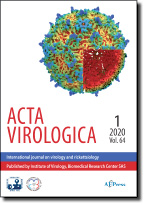Acta Virologica Vol.65, No.3, p.279-287, 2021
|
| Title: Scavenger receptor class B type I is more conducive for genotype 1b hepatitis C virus internalization than low-density lipoprotein receptor |
| Author: Xiangyi Cao, Qiong Kang, Jiang Deng, Jun Xiao, Yanyu Zhang, Ping Ma, Xiaoang Yang, Liping Lv |
|
Abstract: The current limited understanding of HCV entry mechanisms hinders the development of specific antiviral drug screening techniques and vaccine assessment. HCV subtypes and cellular surface proteins both can affect virus tropism. Human factors such as low-density lipoprotein receptor (hLDLR), CD81 (hCD81), scavenger receptor class B type I (hSR-BI), claudin 1 (hCLDN1), and occludin (hOCLN) assist HCV entry into hepatocytes. Here, we studied the importance of five human proteins in the process of cell culture-derived (HCVcc) and serum-derived (HCV-sd) HCV entry using constructed humanized mouse hepatocytes and mouse models. We determined that unlike hLDLR, hSR-BI was an indispensable factor for 1b genotype HCV adsorption. Furthermore, this attachment can be completely prevented by treatment with a monoclonal antibody targeting hSR-BI. Our data support the idea that SR-BI is an essential factor in HCV infection, particularly during the initial HCV particle-binding step. This novel finding will facilitate the development of antiviral drugs and vaccines.
|
|
| Keywords: hepatitis C virus; virus internalization; model construction; hSR-BI |
|
|
Published online: 06-Aug-2021
|
| Year: 2021, Volume: 65, Issue: 3 |
Page From: 279, Page To: 287 |
doi:10.4149/av_2021_307
|
|
 download file download file |
|
|
|
|
 download file
download file
